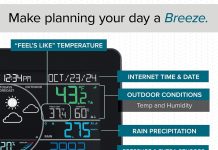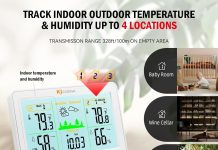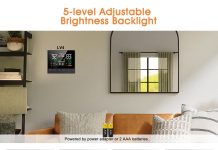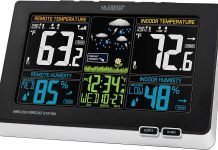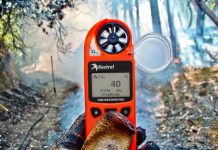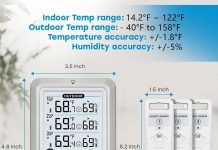Curious about the longevity of home weather station sensors? We’ve got you covered! In this article, we explore the lifespan of these essential devices, shedding light on just how long they last before requiring replacement. So, if you’re looking to ensure accurate weather updates day in and day out, stick around and find out the ins and outs of your trusty home weather station’s sensor lifespan.
Review contents
Factors Affecting Sensor Lifespan
Weather sensors are an essential component of home weather stations, providing accurate data that helps us better understand and prepare for the weather conditions around us. However, like any electronic device, these sensors have a limited lifespan. Several factors can affect how long a sensor will last before requiring replacement.
Quality of the Sensor
The quality of the sensor itself is one of the most significant factors determining its lifespan. Higher-quality sensors are typically built to withstand a wider range of environmental conditions and are more resistant to wear and tear. Investing in a sensor from a reputable manufacturer known for producing reliable and durable sensors can greatly extend its lifespan.
Environmental Conditions
The environment in which a sensor is installed plays a crucial role in determining its longevity. Extreme temperatures, high humidity, exposure to direct sunlight, and other harsh weather conditions can significantly impact the lifespan of a sensor. Sensors that are exposed to frequent and severe weather conditions may deteriorate more quickly than those that are installed in more controlled environments.
Maintenance and Care
Proper maintenance and care are essential for extending the lifespan of weather sensors. Regularly cleaning the sensors to remove dirt, dust, and other contaminants helps prevent any buildup that could affect their accuracy. Additionally, inspecting the sensors for physical damage, such as corrosion or loose wires, and addressing any issues promptly can also help prolong their lifespan. It’s important to refer to the manufacturer’s guidelines for specific maintenance instructions.
Frequency of Use
The frequency at which a weather sensor is used can also impact its lifespan. Sensors that are constantly collecting and transmitting data may experience more wear and tear than sensors that are used less frequently. However, this factor may not be as significant for home weather station sensors, as they are typically designed for continuous use.
Sensor Types
Different weather sensors are designed to measure various meteorological parameters, each serving a specific purpose. Understanding the types of sensors available can help us choose the right ones for our weather station and assess their lifespan.
Temperature Sensor
Temperature sensors measure the ambient temperature of the surroundings. They are commonly used in weather stations to provide accurate readings of the current temperature. The lifespan of temperature sensors can vary depending on their quality and environmental conditions.
Humidity Sensor
Humidity sensors measure the amount of moisture in the air. They are crucial for tracking humidity levels, which can have significant implications for our comfort and health. Like other sensors, the lifespan of humidity sensors can be influenced by factors such as quality, environment, and maintenance.
Barometric Pressure Sensor
Barometric pressure sensors, also known as atmospheric pressure sensors, measure the air pressure exerted by the atmosphere. These sensors help determine changes in weather patterns and provide valuable information for forecasting. The lifespan of barometric pressure sensors can vary and is affected by similar factors as other sensors.
Wind Speed and Direction Sensor
Wind sensors measure the speed and direction of the wind. They are essential for monitoring wind conditions and are commonly used in weather stations. The lifespan of wind sensors can depend on factors such as build quality, exposure to extreme wind conditions, and regular maintenance.
Rain Gauge Sensor
Rain gauge sensors measure the amount of precipitation, such as rain or snow, that has fallen in a given period. These sensors are crucial for understanding local rainfall patterns and can help assess water availability. The lifespan of rain gauge sensors can vary depending on their construction and exposure to extreme weather conditions.
UV Index Sensor
UV index sensors measure the intensity of ultraviolet (UV) radiation from the sun. They provide valuable information about the potential health risks associated with sun exposure. The lifespan of UV index sensors is affected by factors such as build quality, exposure to sunlight, and regular maintenance.
Expected Lifespan of Different Sensors
While it’s challenging to provide an exact lifespan for each sensor type, we can offer some general guidelines based on our research and experience.
Temperature Sensor
Temperature sensors generally have a lifespan of several years, with some high-quality sensors lasting up to a decade or more. However, it’s important to note that exposure to extreme temperatures can accelerate the degradation of these sensors.
Humidity Sensor
Humidity sensors typically have a lifespan of several years, similar to temperature sensors. Their longevity can be influenced by exposure to high humidity levels, which can cause corrosion and affect their accuracy.
Barometric Pressure Sensor
Barometric pressure sensors can also last several years, with the lifespan depending on factors such as quality, usage, and environmental conditions.
Wind Speed and Direction Sensor
Wind sensors are often exposed to harsh conditions, including strong winds and debris, which can impact their lifespan. On average, wind sensors can last anywhere from 5 to 10 years, with regular maintenance and care.
Rain Gauge Sensor
Rain gauge sensors are typically designed to withstand outdoor conditions and can last for several years. However, exposure to extreme weather conditions, such as hail or heavy snow, can potentially damage them.
UV Index Sensor
UV index sensors can last for several years, similar to other sensors. However, exposure to direct sunlight and prolonged exposure to high UV levels can affect their accuracy and lifespan.
It’s important to note that these estimates are based on general observations and can vary depending on the specific sensor model, quality, usage, and environmental conditions.
Signs of Sensor Wear and Tear
Over time, weather sensors may exhibit signs of wear and tear. Recognizing these signs is crucial for ensuring accurate data collection and maintaining the overall functionality of the weather station.
Inaccurate Readings
One of the most apparent signs of sensor wear and tear is consistently inaccurate readings. If the sensor starts providing data that deviates significantly from the expected values or shows inconsistencies over time, it may indicate that the sensor is no longer functioning correctly.
Inconsistent Data Transmission
Another sign of sensor wear and tear is inconsistent data transmission or loss of connection. If the sensor begins to experience frequent connection issues or data dropouts, it may signify underlying problems with the sensor or its communication components.
Physical Damage
Physical damage to the sensor itself or its connecting cables is also a clear indication of wear and tear. Corrosion, loose wires, or visibly damaged components should be addressed promptly to prevent further issues or inaccurate data collection.
Malfunctioning or Non-responsive
If the sensor stops responding altogether or malfunctions, it is a clear indicator that it may need to be replaced. Malfunctioning sensors may exhibit erratic behavior, stop collecting data entirely, or fail to respond to calibration attempts.
Prolonging Sensor Lifespan
While weather sensors have a limited lifespan, there are steps we can take to extend their longevity and ensure accurate data collection.
Proper Placement
Proper sensor placement is crucial for protecting sensors from extreme weather conditions and maximizing their lifespan. Placing sensors away from direct sunlight and potential sources of interference, such as buildings or trees, can help shield them from unnecessary wear and tear.
Regular Calibration
Regular calibration is essential for maintaining the accuracy of weather sensors. Following the manufacturer’s guidelines for calibration intervals and procedures can help ensure that sensors continue to provide reliable and precise data over time.
Protecting from Extreme Weather
Protecting sensors from extreme weather conditions, such as intense heat, heavy rain, or freezing temperatures, can prevent damage and prolong their lifespan. Using protective covers, shelters, or enclosures designed specifically for weather sensors can help shield them from these potentially damaging elements.
Cleaning and Maintenance
Regularly cleaning and performing routine maintenance on sensors is crucial for preventing the accumulation of dirt, dust, or other contaminants that could affect their accuracy. Following the manufacturer’s instructions for cleaning and maintenance can help keep sensors in optimal condition.
Replacing Sensors
Despite our best efforts, weather sensors will eventually reach the end of their useful lives. Knowing when and how to replace them is essential for ensuring continuous and accurate data collection.
When to Replace
When considering sensor replacement, it’s important to monitor their performance closely. If sensors consistently provide inaccurate readings, experience frequent connection issues, or exhibit physical damage, it may be time to replace them. Additionally, if the manufacturer’s estimated lifespan has been exceeded or if the sensors are beyond repair, replacement becomes necessary.
Where to Purchase
When purchasing replacement sensors, consider reputable vendors and manufacturers known for producing reliable products. Researching customer reviews and seeking recommendations can help ensure the quality and longevity of the new sensors.
Installation and Compatibility
Proper installation of the new sensors is crucial for their optimal functionality. Following the manufacturer’s guidelines and recommendations for installation procedures can help prevent any compatibility issues and ensure accurate data collection.
Comparison of Different Sensor Brands
Comparing different sensor brands and models can help us choose the most suitable replacement sensors for our weather station. Consider factors such as build quality, accuracy, longevity, and customer reviews when evaluating different options.
Cost Considerations
When replacing sensors, it’s crucial to consider the associated costs. While higher-quality sensors may come with a higher price tag, they often offer improved accuracy and longer lifespans, making them a wise investment in the long run.
DIY Sensor Replacement
Replacing weather sensors can be a straightforward process with the right knowledge and tools. However, it’s important to follow proper procedures to ensure accurate installation and minimize the risk of damaging the new sensors.
Step-by-Step Guide
-
Start by disconnecting the power source of the weather station to avoid any electrical issues during the replacement process.
-
Carefully remove the old sensor from its mounting location, following the manufacturer’s guidelines and instructions.
-
Take note of the wiring connections and labels to ensure proper reconnection of the new sensor.
-
Install the new sensor in the designated mounting location, ensuring it is securely fastened and aligned according to the manufacturer’s instructions.
-
Connect the wiring of the new sensor to the appropriate terminals, following the labels or color-coding.
-
Restore the power to the weather station and verify that the new sensor is functioning correctly by checking for accurate readings and proper data transmission.
Tools and Equipment Needed
Common tools and equipment needed for sensor replacement include:
- Screwdrivers (size and type may vary)
- Wire cutters/strippers
- Gloves (to protect against static and physical damage)
- Protective goggles (optional but recommended)
- Workbench or a clean, stable surface for safe sensor handling
It’s essential to refer to the manufacturer’s guidelines and specific instructions for any additional tools or equipment required for the precise replacement process.
Common Issues and Troubleshooting Tips
During the sensor replacement process, some common issues may arise. Here are a few troubleshooting tips to help address them:
-
If the new sensor is not providing any readings, double-check the wiring connections to ensure they are securely connected.
-
In case of inaccurate readings, verify that the new sensor is properly calibrated according to the manufacturer’s instructions.
-
If the weather station is not receiving data from the new sensor, ensure that the communication channels are properly set up and there are no firmware or software compatibility issues.
If troubleshooting efforts do not resolve the issue, it may be necessary to consult the manufacturer’s support or seek professional assistance.
Professional Sensor Replacement
For those who prefer to leave the sensor replacement to professionals or lack the time or expertise to perform the task themselves, there are service providers available to handle the replacement process.
Finding Reliable Service Providers
When seeking professional sensor replacement services, it’s crucial to find reliable and reputable service providers. Reading customer reviews, seeking recommendations from trusted sources, and checking for any necessary certifications or qualifications can help ensure a smooth and satisfactory experience.
Cost vs. Convenience
Professional sensor replacement services may incur additional costs compared to a DIY approach. However, the convenience and peace of mind that come with professional assistance can outweigh the expense for some individuals.
Things to Consider Before Hiring
Before hiring a professional service provider for sensor replacement, consider the following:
- Verify the service provider’s expertise and experience in handling weather sensors.
- Inquire about any warranties or guarantees provided for the replacement sensors and the overall service.
- Request an estimate of the total cost, including any potential additional charges for equipment, labor, or travel.
- Discuss the timeline for the replacement process to ensure it aligns with your schedule and requirements.
Future Advancements in Sensor Technology
As technology continues to advance, we can expect exciting developments in weather sensor technology. These advancements aim to improve accuracy, convenience, and the overall functionality of home weather stations.
Emerging Trends
Emerging trends in weather sensor technology include:
- Miniaturization: Sensors becoming smaller in size while maintaining or improving their accuracy.
- IoT Integration: Sensors becoming increasingly connected to the Internet of Things (IoT), allowing for seamless data transmission and smart home integration.
- Data Analytics: Advancements in cloud-based data analytics for weather data, enabling more accurate forecasting and personalized insights.
Improved Battery Life
Future weather sensors may feature improved battery life, reducing the need for frequent battery replacements or recharging. Longer battery life would enhance the convenience and reliability of weather stations.
Wireless Connectivity
The adoption of wireless connectivity in weather sensors allows for easier installation and data transmission. Wireless sensors eliminate the need for complex wiring systems and make it simpler to integrate sensors into existing home weather stations.
Smart Home Integration
Smart home integration is a growing trend in home automation. Weather sensors that seamlessly integrate with smart home systems allow for automatic adjustments to lighting, temperature, and other environmental factors based on real-time weather conditions.
Cloud-based Data Analytics
Cloud-based data analytics platforms offer the potential for more accurate weather forecasting and insights based on extensive data analysis. Future weather sensors may leverage cloud-based solutions to provide users with personalized weather forecasts and relevant recommendations.
Conclusion
Understanding the factors that affect sensor lifespan, the expected lifespan of different weather sensors, signs of wear and tear, and ways to extend their lifespan is crucial for maintaining accurate and reliable weather data collection. Regular maintenance, proper placement, and conscious purchase decisions can greatly contribute to the longevity and functionality of weather sensors. Whether replacing sensors through a DIY approach or seeking professional assistance, being informed about the process is essential. As technology advances, future advancements in weather sensor technology hold the promise of improved accuracy, convenience, and integration into smart home ecosystems. With the right combination of care, maintenance, and periodic replacement, home weather stations can continue to provide valuable information and insights for years to come.


